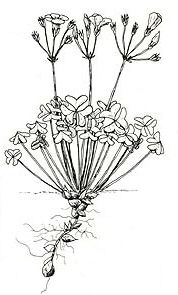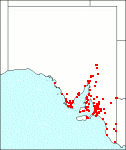Family: Oxalidaceae
Oxalis pes-caprae
Citation:
-caprae, L., Sp. Pl. 434 (1753).
Synonymy: O. cernua Thunb., Diss. Oxal. 14 (1781).
Common name: Soursob, soursop, Bermuda buttercup.
Description:
Bulbs ovoid, 2-3 cm long, pointed; tunics brown; bulbils formed on the rhizome and in the axils of the basal leaves; stem hardly exserted, only developed when the plants are crowded or shaded; leaves numerous; petioles 5-20 cm, with a few hairs, broadened at the base; leaflets 3, cuneate-obcordate, 1-3 cm long, 1-4 cm broad, with a deep incision, glabrous above, sparsely hairy below, often with purple flecks on the upper-surface.
Peduncles to 40 cm, with 3-25 flowers in an umbel; sepals lanceolate, 5-7 mm long, with simple and glandular hairs, usually with 2 calli at the apex, rarely with dark spots at the top and the base; petals yellow, 15-25 mm long; capsule c. 8 mm long, the upper part pubescent; rarely plants with double sterile flowers.

| Oxalis pes-caprae habit.
|
Image source: fig 386c in Jessop J.P. & Toelken H.R. (Ed.) 1986. Flora of South Australia (4th edn).
|
Published illustration:
Cunningham et al. (1982) Plants of western New South Wales, p. 436; C. Lamp (1976) Weeds in Australia, p. 229.
|
|
Distribution:
|
Field distribution is only extensive in the SL and NL regions. Natural barriers to further spread are low rainfall in April-Nov., low winter temperature with several frosts a year, infertile soils and absence of rivers. The latter play an important part in dispersal. (Michael, P., 1958. Some aspects of the ecology and physiology of soursob (Oxalis pes-caprae). Ph.D. thesis, University of Adelaide).
S.Aust.: FR, EP, NL, MU, YP, SL, KI, SE. All mainland States. Native to South Africa. Grows in gardens and orchards, along roadsides and arable land.
|
Conservation status:
naturalised
Flowering time: June — Nov.
|

SA Distribution Map based
on current data relating to
specimens held in the
State Herbarium of South Australia
|
Biology:
Continual consumption by sheep involves chronic kidney damage and may result in death.
Taxonomic notes:
2 chromosome races occur here. The largest populations are short-styled sterile pentaploids (5n = 35); there are also small populations of fertile tetraploids (4n = 28) with all 3 style-lengths.
Author:
Not yet available
|

